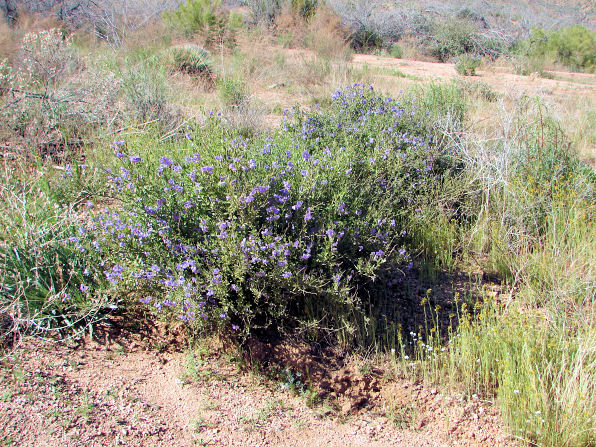Arizona Wild Flowers
Pictures, Photos, Images
Descriptions, Information, Reviews.
Chaparral Nightshade, Solanum xanti.
We Are Proud Of Our SafeSurf Rating!
Click On Any Of The Following Links By Amazon.Com
For Books, & Videos About Wildflowers Of Arizona & The Southwest USA. No Obligation!
 |
| Chaparral Nightshade, Solanum xanti. Plant Photo Taken March 16, 2009. Horseshoe Lake, Arizona. |
|---|
| Chaparral Nightshade, Solanum xanti. Plant Photo Taken March 16, 2009. Horseshoe Lake, Arizona. |
| Chaparral Nightshade. Solanum xanti. | Chaparral Nightshade. Solanum xanti. |
|---|
Chaparral Nightshade.
We wish to thank Wikipedia, the free encyclopedia for some of the information on this page. We share images and information with Wikipedia. Solanum xanti, known commonly as chaparral nightshade or San Diego nightshade, is a member of the genus Solanum. Some garden shops are selling it as; 'Mountain Pride'. It is native to the southwestern United States and Baja California, Mexico, where it grows in chaparral, woodlands, forests, and some other habitats. Chaparral Nightshade is a perennial herb or subshrub producing a branching hairy stem up to about 3 feet in maximum height. Its leaves are up to 4 inches long and are lance-shaped to oval, mostly unlobed except for occasional lobes at the bases of the blades. It has an umbel-shaped inflorescence with many purple-blue flowers up to 1 inch wide. The fruit is a green berry � inch in diameter.
Quick Notes:
Height: Up To About 3 feet. Spreading out to about 5 foot wide.
Flowers: Violet - blue. The flowers have 5 lobes, 5 stamens, and are 1 inch in diameter. The flowers have 5 fused petals, � inch across, with bright yellow stamens. Flowers grow on stalks in clusters or singly at the end of stems or branches.
Flowering Time: May to October.
Fruit: The fruits are yellow to brownish, juicy berries, � inch in diameter. Seeds are flat, brown and 1/10 to 1/5 inch long.
Shape: Prostrate, branched, radiating to 5 feet from top of taproot, hairy, becoming nearly glabrous.
Leaves: The silvery leaves are oblong to lance-shaped with wavy edges. Poisonous. The leaves are 1 to 4 inches long by 1 inch wide, they are covered with short, silvery-white, star-shaped hairs that give the plant a dusky or silvery-gray color.
Found: Native to the southwestern United States, (AZ, CA, NM, NV, UT); as well as far south as northern Mexico. ( Sonora, and Baja California ). Native to Mojave, Sonora, and Colorado deserts.
Hardiness:
USDA Zone 8b: to -9.4 �C (15 �F)
Soil pH requirements:
Sun Exposure:
Elevation: 0 to 4,500 Feet.
Habitat: Chaparral, woodlands, forests.
Miscellaneous: Flowering Photos Taken March 16, 2009. Horseshoe Lake, Arizona.
|
We Are Proud Of Our SafeSurf Rating!
Click On Any Of The Following Links By Amazon.Com
For Books, & Videos About Wildlife Of Arizona & The Southwest USA. No Obligation!
| © 1966 - Present, Audrey, Eve, & George DeLange |